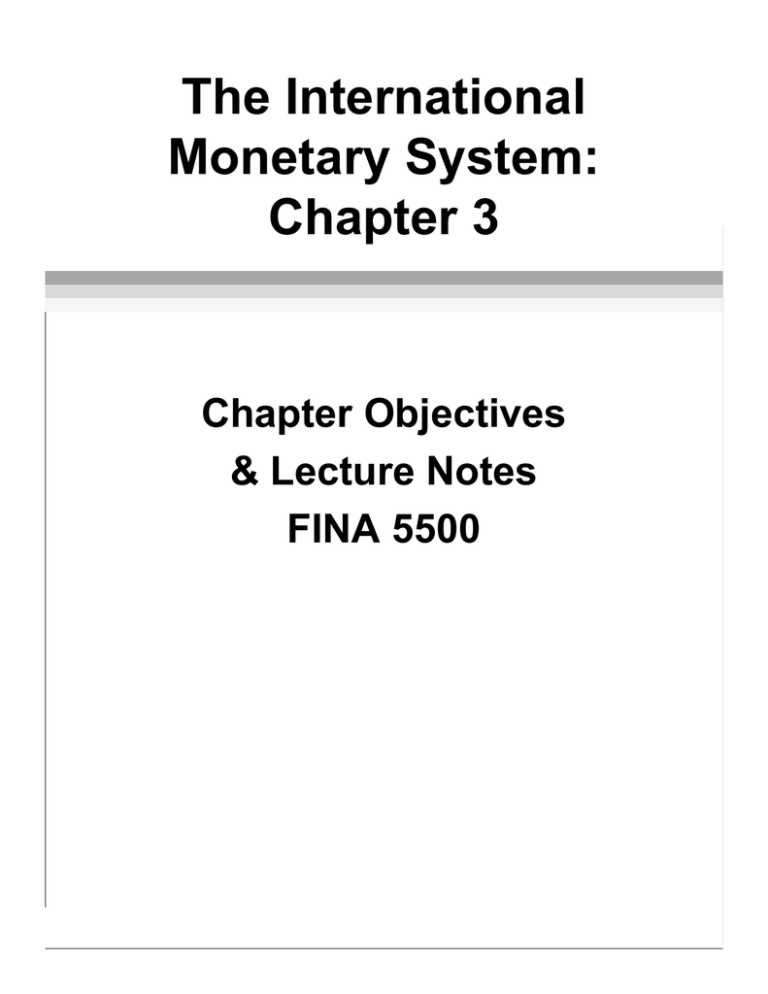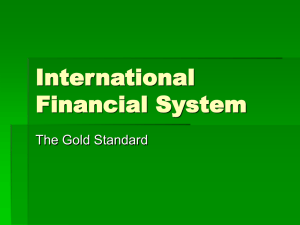The International Monetary System: Chapter 3 Chapter Objectives
advertisement

The International Monetary System: Chapter 3 Chapter Objectives & Lecture Notes FINA 5500 Chapter Objectives: FINA 5500 Chapter 3 / The International Monetary System 1. To be able to compare and contrast the mechanics of the fixed and floating exchange rate systems 2. To be able to explain in your own words, the effects of changes in one country’s inflation and unemployment rates on the economies of other countries under a fixed exchange rate system 3. To be able to explain in your own words, the effects of changes in one country’s inflation and unemployment rates on the economies of other countries under a floating exchange rate system 4. To be able to compare and contrast the strengths and weaknesses of the fixed and floating exchange rate systems 5. To be able to relate in your own words, the historical evolution of the European Union and the events leading to the adoption of a Single European Currency, the Euro 6. To be able to explain in your own words the pros and cons of having a Single European Currency 7. To be able to explain in your own words, how a pegged exchange rate system works 8. In a three country case when Country A has its currency pegged to the currency of Country B, while the currency of Country C is floating against the currencies of both Countries A and B, you should be able to analyze the effects of an appreciation and depreciation of the floating currencies on the levels of export and import between each pairs of the countries (AB, BC and AC). CHAPTER 3: OVERVIEW z Various Types of Exchange Rate Systems: » Fixed Rate / Floating Rate / Managed Float / Pegged Exchange Rate z z z Comparing advantages / disadvantages of fixed and floating rate systems The European Union and Euro Implications of pegged exchange rate systems and its impact on international trade 1 Fixed Exchange Rate Systems: History z z z z Gold Standard: 1821 - 1914 Gold Exchange Standard: 1925 - 1931 Bretton Woods System: 1946 - 1971 Smithsonian Agreement: 1971 to 1973 2 1 Fixed Exchange Rate System: Mechanics z z z z z z The price of a country country’ss currency is fixed in terms of gold or other currency A country’s money supply is constrained by its gold or other currency reserve A change in the price level in one country will affect its balance of payments (BOP) Th resulting The lti change h in i BOP will ill affect ff t its it reserve The change in reserve will affect its money supply and price levels Supposed to provide price stability and promote international trade 3 Floating Exchange Rates System: History & Mechanics z z z z z 1973 to present Major currencies float (continuous adjustment) The U.S. actually has a dirty float due to informal "Exchange Rate Target Zones” Minor currencies are pegged to major currencies Exception: European Monetary System has fixed rates within, but floating outside 4 2 Comparison of Fixed and Floating Exchange Rate Systems z The Impact of Rise in Inflation (in the US): » Fixed Exchange Rate System » Floating Exchange Rate System z The Impact of a Rise in Unemployment (in the US): » Fixed Exchange Rate System » Floating Exchange Rate System 5 The Impact of Rise in Inflation (US): Fixed Exchange Rate System » » » » UK goods cheaper in the US Import from UK increases Excess demand for goods in UK Price levels (inflation) in UK also go up Fixed Exchange Rate System 6 3 The Impact of Rise in Inflation (US): Floating Exchange Rate System » UK goods cheaper in the US » Import from UK increases –increased demand for pounds » Export to UK decreases –decreased supply for pounds » Value of Pound (Dollar) increases (decreases) » UK goods become more expensive (because of currency appreciation) only to US buyers » Domestic inflation in UK is not affected 7 Comparison of Fixed & Floating Exchange Rate Systems: Inflation z Floating Rate Exchange Rate System: » Advantage: Inflation in one country does not necessarily lead to inflation in other countries » Disadvantage: Since prices of UK goods are high (due to appreciation of BP), domestic producers can get away with higher prices in the US (less international competition) 8 4 The Impact of Rise in Unemployment (US): Fixed Exchange Rate System » Import from UK decreases » Reduced demand for goods in UK » Lower productivity in the UK » Higher unemployment in UK 9 The Impact of Rise in Unemployment (US): Floating Exchange Rate System » Import from UK decreases –decreased demand for pounds » Value of Pound (Dollar) decreases (increases) » UK goods now become less expensive (because of pound depreciation) to US buyers goods is » Some of the demand reduction for UK g offset (because of pound depreciation) » Unemployment rate in the UK does not rise. 10 5 Comparison of Fixed and Floating Exchange Rate Systems: Unemployment z Floating Exchange Rate System: » Advantage: High unemployment in one country does not necessarily lead to high unemployment in other countries » Disadvantage: – – – – – – – High unemployment in US decreased imports from UK Reduced demand for pounds pound depreciates UK goods becomes cheaper in the US increased imports from UK Unemployment in US goes up even further 11 Comparison of Fixed and Floating Exchange Rate Systems: A Summary z Fixed Exchange Rate System: » Disadvantage: Economic problems (inflation (inflation, unemployment) in one country can infect other countries » Advantages: – Built in price stability mechanism – Promotes international trade z Floating Exchange Rate System: » Advantage: Economic problems (inflation (inflation, unemployment) are generally contained within the country where they originate. » Disadvantage: Economic problems can become more pronounced in the country of origin. 12 6 European Union: Historical Landmarks z European Economic Community: 1957 » France / West Germanyy / Italy y / Belgium g / Netherlands / Luxembourg z European Union: 1970 - 1990’s » Enlargement: – Great Britain / Ireland / Denmark (1973); Greece (1981) ; Spain / Portugal (1986) ; Austria / Finland / Sweden (1995) z A Single European Market » Reduction or elimination of tariffs and duties for trades among member countries z z z Single European Act (1987) European Currency Unit (1990’s) and its failure Maastricht Treaty: Establish criteria for euro membership 13 The Maastricht Criteria The Maastricht Treaty stipulated five criteria that European countries had to meet to become eligible for Euro: Price Stability: A country's inflation rate must not exceed the average inflation rate of the 3 best performing member states by more than 1.5%. The Level of Government Deficit : The government’s budget deficit must not be more than 3 % of its gross domestic product. The Level of Government Debt : The government’s total debt must not be more than 60 % of its gross domestic product. Successful EMS Membership : A country must have participated in Exchange Rate Mechanism of the European Monetary System for at least two years, without devaluing against the currency of any other Member State. Interest-Rate Convergence : Its average nominal long-term interest rate should not be more than 2 % higher than those prevailing in the three best performing Member States in terms of price stability. 14 7 Why a Single European Currency? Next Logical Step: A single market concept cannot survive for long without a single currency Transaction Costs: Reduce the cost of converting currencies No Exchange Rate Uncertainty: Eliminates the risks of unforeseen exchange rate revaluations or devaluations. Transparency & Competition : Increase direct comparability of prices and wages across Europe Strength: The new Euro will be the among the strongest currencies in the world, along with the US Dollar and the Japanese Yen. C it l M Capital Market: k t A llarger E Euro zone will ill iintegrate t t th the E European fifinancial i l markets No Competitive Devaluations: Countries can no longer devalue their currencies against each other to increase their exporters Fiscal Discipline: Governments with a lack of fiscal discipline can be brought into line. European Identity: One currency will strengthen the European identity. z z z z z z z z z 15 Euro Introduction: Timetable z Membership into Euro granted to 11 nations (5/98) z Conversion C i rates t b between t euro and d national ti l currencies i are irrevocably fixed (12/31/98) z Euro becomes official currency for those 11 nations (1/1/99) Austria / Belgium / France / Finland /Germany / Ireland / Italy / Luxembourg / Netherlands / Spain / Portugal becomes 12th member (1/1/01) z Euro banknotes and coins start circulating (1/1/02) z The circulation of currencies of 12 nations ends (2/28/02) z Greece 16 8 Euro Prices 17 A Single European Currency: Possible Disadvantage z z z z z z Cost of Introduction: Converting all bills, all wages and prices into Euro is expensive Non-Synchronicity of Business Cycles: Business cycles across the various countries do not move in synchronicity. Fiscal Policy Spillovers: With a Europe-wide interest rate, individual countries that increase their debt will raise interest rates in all other countries No Competitive Devaluations: In a recession, a country can no longer stimulate its economy by devaluing its currency and increasing exports. Central Bank Independence: It will be difficult for the new European Central Bank (ECB) to maintain its independence, in spite of pressure from member countries Excessive Fiscal Discipline: The pressure on a member government to limit budget deficit could adversely affect that country’s economy 18 9 Pegged Exchange Rates z Sometimes countries have their currencies pegged to a major currency (e (e.g., g Argentina Argentina, Mexico, South Korea, Hong Kong, have had their currencies pegged to the US dollar) » The formal pegging arrangement can vary (ERM, currency boards, etc) z z These currencies float against other currencies We examine implications of pegging for the economies of countries involved 19 Pegged Exchange Rates: Three Currency Case: USA, Mexico, Argentina z Argentinan Peso (AP): » Pegged to U.S. dollar at $ 0.75/AP » Floats against the MP z Mexican Peso (MP): » Floats against the dollar at $ 0.125/MP » Floats against the AP z Initial AP to MP exchange rate must be: » 1 AP costs MP 6.00 (0.75 / 0.125) » 1 MP costs AP 0.167 (0.125 / 0.75) 20 10 Pegged Exchange Rates: USA, Mexico, Argentina: Dollar Appreciates Against MP z Dollar appreciates to $ 0 0.100/MP 100/MP (from $0 $0.125/MP) 125/MP) » AP to dollar is pegged at AP 0.75/$. » AP to MP floats, new rates are: – 1 AP now costs MP 7.5 (0.75 / 0.100) – 1 MP now costs AP 0.133 (0.100 / 0.75) z The Argentinan Th A ti P Peso also l appreciates i t against i t th the Mexican Peso 21 Pegged Exchange Rates: USA, Mexico, Argentina: Dollar Appreciates Against MP z International Trade: USA and Mexico: » US demand for Mexican goods (US imports) increases » Mexican demand for US goods (US exports) decreases » US BOT with Mexico is reduced 22 11 Pegged Exchange Rates: USA, Mexico, Argentina: Dollar Appreciates Against MP z International Trade: Argentina and Mexico: » » » » The value of AP rises against the MP Argentinan demand for Mexican goods increases Mexican demand for Argentinan goods decreases Argentinan BOT with Mexico is reduced 23 Pegged Exchange Rates: USA, Mexico, Argentina: Dollar Appreciates Against MP z International Trade: USA and Argentina: » Since AP has appreciated against MP but is fixed against $, Argentina will shift imports from US to Mexico. US exports to Argentina will reduce and Argentinan imports from Mexico will rise. » Since the $ has appreciated against MP but is fixed against AP, AP USA will shift imports from the Argentina to Mexico. 24 12 Pegged Exchange Rates: USA, Mexico, Argentina: Dollar Appreciates Against MP z International Trade: Overall effects: » Mexico's ( the country with depreciated floating currency) economy will be stimulated, because of increased demand for its goods from USA and Argentina » Reduced volume of trade between USA and Argentina (country with pegged currency) 25 Pegged Exchange Rates: USA, Mexico, Argentina: Dollar Depreciates Against MP z Dollar depreciates to $ 0 0.15/MP 15/MP (from $0 $0.125/MP) 125/MP) » AP to dollar is pegged at AP 0.75/$. » AP to MP floats, new rates are: – 1 AP now costs MP 5.0 (0.75 / 0.15) – 1 MP now costs AP 0.20 (0.15 / 0.75) z The Argentinan Th A ti Peso P also l depreciates d i t against i t the th Mexican Peso 26 13 Pegged Exchange Rates: USA, Mexico, Argentina: Dollar Depreciates Against MP z International Trade: USA and Mexico: » US demand for Mexican goods (US imports) decreases » Mexican demand for US goods (US exports) increases » US BOT with Mexico is increased 27 Pegged Exchange Rates: USA, Mexico, Argentina: Dollar Depreciates Against MP z International Trade: Argentina and Mexico: » » » » The value of AP falls against the MP Argentinan demand for Mexican goods decreases Mexican demand for Argentinan goods increases Argentinan BOT with Mexico is increased 28 14 Pegged Exchange Rates: USA, Mexico, Argentina: Dollar Depreciates Against MP z International Trade: USA and Argentina: » Since AP has depreciated against MP but is fixed against $, Argentina will shift imports from Mexico to US. US exports to Argentina will rise and Argentinan imports from Mexico will fall. » Since the $ has depreciated against MP but is fixed against AP, AP USA will shift imports from the Mexico to Argentina. 29 Pegged Exchange Rates: USA, Mexico, Argentina: Dollar Depreciates Against MP z International Trade: Overall effects: » Mexico's ( the country with appreciated floating currency) economy will be hurt, because of reduced demand for its goods from USA and Argentina » Increased volume of trade between USA and Argentina (country with pegged currency). Argentina and US economies will be stimulated. stimulated 30 15





